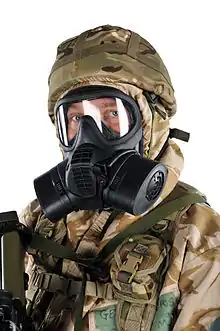General Service Respirator
The General Service Respirator is a military gas mask designed to replace the previous S10 respirator for the British Armed Forces. It was designed by DSTL and Scott Safety in collaboration with the MoD, and was manufactured by Scott Safety. Avon Protection now manufacture the GSR from their factory in Melksham after winning the in-service support contract in 2019.
| General Service Respirator | |
|---|---|
 British soldier with the GSR | |
| Type | Gas mask |
| Place of origin | United Kingdom |
| Service history | |
| In service | 2010-Present |
| Used by | British military |
| Production history | |
| Designer | Defence Science and Technology Laboratory British Ministry of Defence |
| Designed | 2000-2009 |
| Manufacturer | Scott Safety |
| Produced | 2010-Present |
History
Design work started in 2000, and from the outset the GSR was designed to function better than the S10 in "hot, high and dry" environments whilst still keeping the S10's qualities in the temperate environments of Europe it was originally designed for. It was also designed to be worn for longer periods than the S10, having been designed for 24 hours of continuous use in CBRN environments as opposed to the previous design level of 4 hours.
The respirator was officially adopted into service with the Armed Forces on 26 August 2010, and training started during 2011, with British Forces Germany being first to field them. All new personnel are trained in use of the system. Existing personnel will be trained through refresher courses, starting with the British Army, and continuing with the Royal Navy, Royal Air Force and the Royal Fleet Auxiliary. By January 2015, all 300,000+ respirators had been delivered to the British Armed Forces.[1]
Features
The new respirator, produced by Scott Health and Safety Ltd, reportedly provides a significantly higher level of protection. Features which differentiate it from the S10 which it replaced are:
- Twin filter canisters (can be changed more easily while in a CBRN environment)
- Single visor (better visibility and reduces the claustrophobic effect)
- Improved drinking system (water can be passed through the system at a higher rate)[2]
- Ability to convert to EU standard canisters with a simple modification
References
- desider (PDF). Ministry of Defence. 9 January 2015. Retrieved 9 January 2015.
- https://www.youtube.com/watch?v=j0UQBHirYpI
| Wikimedia Commons has media related to General Service Respirator. |